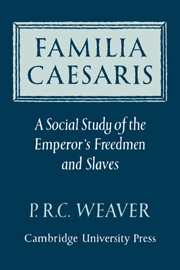1 - Dated inscriptions
Published online by Cambridge University Press: 07 October 2011
Summary
Two kinds of dated inscriptions are important for the Familia Caesaris: (a) those that can be dated to within a particular year; (b) those that can be dated to within a particular reign. The value of both kinds is that they provide fixed points of reference for the use of particular formulae in nomenclature. They help to establish the chronological range of usages which in suitable circumstances, either individually or in combination, can then become secondary dating criteria. This applies to the nomen gentilicium, status indication, agnomina, occupational titles and abbreviations.
(a) Precise dating of the inscriptions to within a particular year is comparatively rare for the Familia Caesaris. The commonest form is by the names of consuls, less frequently by the tribunician year of the emperor. But these inscriptions are usually official or quasi-official, including fasti of various kinds, municipal honours, records of collegia especially burial colleges, quarry-marks, brick-stamps and even a military diploma. There are also administrative and private records, including a group of papyrus documents from Egypt in the reign of Augustus. In a few cases the emperor's regnal year in Egypt provides a date. Less than half of these dated inscriptions are private dedications, of which many are those of the form ‘pro salute imp(p).’ in vogue after 161. These do not often contain details of family interest. The other key group, the sepulcrales, is the smallest – only seventeen are precisely dated for both freedmen and slaves.
- Type
- Chapter
- Information
- Familia CaesarisA Social Study of the Emperor's Freedmen and Slaves, pp. 20 - 23Publisher: Cambridge University PressPrint publication year: 1972



